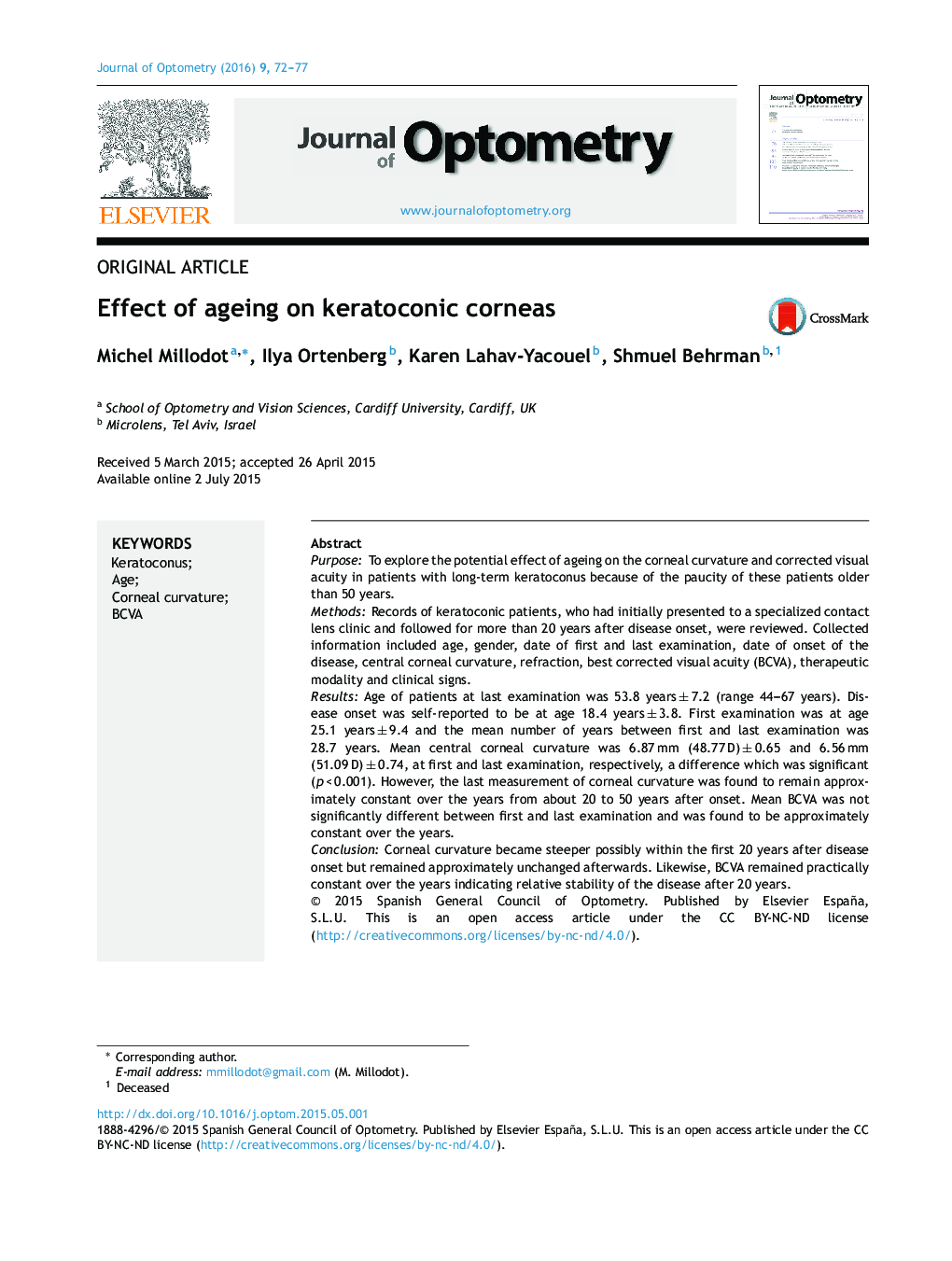| کد مقاله | کد نشریه | سال انتشار | مقاله انگلیسی | نسخه تمام متن |
|---|---|---|---|---|
| 2698723 | 1144061 | 2016 | 6 صفحه PDF | دانلود رایگان |
PurposeTo explore the potential effect of ageing on the corneal curvature and corrected visual acuity in patients with long-term keratoconus because of the paucity of these patients older than 50 years.MethodsRecords of keratoconic patients, who had initially presented to a specialized contact lens clinic and followed for more than 20 years after disease onset, were reviewed. Collected information included age, gender, date of first and last examination, date of onset of the disease, central corneal curvature, refraction, best corrected visual acuity (BCVA), therapeutic modality and clinical signs.ResultsAge of patients at last examination was 53.8 years ± 7.2 (range 44–67 years). Disease onset was self-reported to be at age 18.4 years ± 3.8. First examination was at age 25.1 years ± 9.4 and the mean number of years between first and last examination was 28.7 years. Mean central corneal curvature was 6.87 mm (48.77 D) ± 0.65 and 6.56 mm (51.09 D) ± 0.74, at first and last examination, respectively, a difference which was significant (p < 0.001). However, the last measurement of corneal curvature was found to remain approximately constant over the years from about 20 to 50 years after onset. Mean BCVA was not significantly different between first and last examination and was found to be approximately constant over the years.ConclusionCorneal curvature became steeper possibly within the first 20 years after disease onset but remained approximately unchanged afterwards. Likewise, BCVA remained practically constant over the years indicating relative stability of the disease after 20 years.
ResumenObjetivoExplorar el efecto potencial del envejecimiento sobre la curvatura de la córnea y la agudeza visual corregida en pacientes con queratocono a largo plazo, ya que hay una insuficiencia de estos pacientes con edades superiores a 50 años.MétodosRevisión de las historias de los pacientes con queratocono, que habían acudido inicialmente a una clínica especializada en lentes de contacto, y seguimiento durante más de 20 años desde el inicio de la enfermedad. La información recolectada incluyó edad, sexo, fecha de la primera y la última valoración, fecha de aparición de la enfermedad, curvatura central de la córnea, agudeza visual mejor corregida (BCVA), modalidad terapéutica y signos clínicos.ResultadosLa edad de los pacientes en el último examen fue de 53,8 años ± 7,2 (rango de 44 a 67 años). Los pacientes auto-reportaron el inicio de la enfermedad a los 18,4 años ± 3,8. El primer examen se realizó a los 25,1 años ± 9,4, siendo el número medio de años entre el primero y el último examen de 28,7 años. La media de la curvatura central de la córnea fue de 6,87 mm (48,77 D) ± 0,65 y 6,56 mm (51,09 D) ± 0,74, en el primero y el último examen, respectivamente, una diferencia que resultó significativa (p < 0,001). Sin embargo, se comprobó que la última medición de la curvatura de la córnea permanecía más o menos constante durante el transcurso de los años, durante 20 a 50 años desde el inicio. La BCVA media no resultó estadísticamente diferente entre el primero y el último examen, siendo más o menos constante con el paso de los años.ConclusiónLa curvatura de la córnea resultó más elevada dentro de los 20 primeros años desde la aparición de la enfermedad, pero no sufrió cambios posteriores. De igual modo, la BCVA permaneció prácticamente constante con el paso de los años, lo que indica una estabilidad relativa de la enfermedad con el transcurso de 20 años.
Journal: Journal of Optometry - Volume 9, Issue 2, April–June 2016, Pages 72–77
